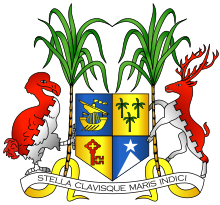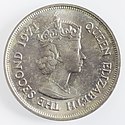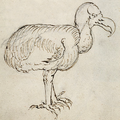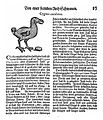Dodo
| Dodo | ||||||||||||
|---|---|---|---|---|---|---|---|---|---|---|---|---|
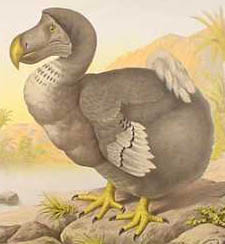
Dodo ( Raphus cucullatus ) |
||||||||||||
| Systematics | ||||||||||||
|
||||||||||||
| Scientific name of the genus | ||||||||||||
| Raphus | ||||||||||||
| Brisson , 1760 | ||||||||||||
| Scientific name of the species | ||||||||||||
| Raphus cucullatus | ||||||||||||
| ( Linnaeus , 1758) |
The Dodo or the dodo , rare Doudo or Dudu ( Raphus cucullatus , "hooded wearing night-bird", former Latin name Didus ineptus ) was a about a meter tall, flightless bird , the only on the island of Mauritius in the Indian Ocean struck. The dodo fed on fermented fruits and nestled on the ground. The research assumes that the species in 1690 became extinct . Its closest relative is the also extinct Rodrigues solitaire ( Pezophaps solitaria ) on the Mascarene island of Rodrigues, which belongs to Mauritius .
Appearance
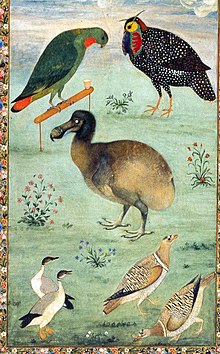
It is known from reports that the dodo had blue-gray plumage, a blackish, curved bill about 23 centimeters long, with a reddish point, and small wings that did not enable it to fly. Furthermore, a tuft of ruffled feathers formed the tail and the bird laid yellow eggs. Dodos were relatively large and weighed over 20 kilograms. The dodo was also unable to fly because of its weak chest muscles. That was not necessary either, since it had no predators on Mauritius.
Traditionally, the dodo has been thought of as a massive, clumsy and awkward bird. The biologist Andrew Kitchen explains the impression the fact that the old drawings superfatted showing captive live birds. Since Mauritius has dry and wet seasons, the dodo may have eaten itself fat at the end of the rainy season in order to survive the dry periods when there was a lack of food. In connection with captivity, where food was available all year round, the dodo was constantly overfed.
One of the few realistic images of a living dodo was created by the Indian painter Mansur at the beginning of the 17th century.
discovery
The first European report on the species comes from the second trip to India by a Dutch fleet under the command of Jacob Cornelisz van Neck in 1598. The ships had been separated in a storm, part of the fleet landed in Mauritius in September of that year ( then still called Ilha do Cerne). A group of sailors sent ashore to search for water and supplies returned with some flightless birds. At that time the island was uninhabited, the birds showed no fear of people. The travel report of the voyage from 1599, called Waarachtige Beschryving (only available in English and other translations), brought the existence of the bird to the attention of the Europeans. According to the description, the birds would have been "twice the size of swans". They were called by the seafarers " Walghstocks or Wallowbirdes " (in later reports also "Walchvoghel") after the dialect expression wallow (Dutch walghe ), which can mean "sickly" or "tasteless". According to the text, the meat was not very tasty and took extremely long cooking to become palatable, so that the sailors preferred other birds. Nevertheless, in numerous later reports of the hunt for the birds as provisions.
The images of the dodos in Waarachtige Beschryving were composed according to stories, that is, according to hearsay, in Europe - the engravers obviously adopted other large birds as patterns. The description is also largely incorrect. Later illustrations, above all in Quinta Pars Indias Orientalis by the de Bry brothers from 1601, were based in part on sketches by ship officers traveling with them and are largely considered to be correct. They were the model for most of the later illustrations.
Lifelike illustrations, which were published much later, were preserved in a ship's journal of the sailor Gelderlandt from 1601 to 1603, which also contained seven bird sketches made from life. The ornithologist Alfred Newton published them in 1896. They show a plump bird with an almost round trunk and a short stump tail consisting of a few feathers. The name Dodo, which later became established in the English-speaking world, first appeared in a report by the travel writer Thomas Herbert from 1634 - according to him, it came from Portuguese.
die out
In 1690 the Englishman Benjamin Harry reported for the last time about a dodo in Mauritius. For others, the last credible account is the story of the sinking of a Dutch fleet under Admiral Arnout de Vlaming in 1662, when some survivors, including the reporter Volkert Evertsz , reached Mauritius in a small boat. Here they caught dodos, but no longer on the main island, but on a small offshore island. In many of the later sighting reports it is assumed that they actually referred to the (also flightless and also exterminated) Mauritius rail , so that the exact time of the disappearance cannot be specified. In any case, the birds were extinct just a few decades after their discovery.
The main reason for the extinction of the species may have been introduced rats as well as imported and feral domestic animals , especially pigs and monkeys , which destroyed the clutches of the ground-breeding birds by eating their eggs. Since the dodo originally had no enemies, it had no escape or defense behavior. The dodo's familiarity and inability to fly made it easy prey for humans too. Although it was not tasty, it was suitable as fresh meat for long voyages. The eggs were also eaten en masse by seafarers. These two dangers have also threatened the existence of the Galápagos giant tortoise and wiped out some of its subspecies.
Less than 100 years after its discovery, the dodo was extinct. Little notice was taken of this until the dodo was mentioned in Alice in Wonderland by Lewis Carroll in 1865 . As the book grew in popularity, so did the bird. Carroll presumably saw the mummified dodo head in the Oxford Natural History Museum.
research
In 2002, a team of researchers from Oxford University led by Beth Shapiro succeeded in isolating fragments of DNA from bones. The DNA comparison showed a close relationship between the dodo and the Rodrigues solitaire, which was also extinct, and the East Asian flying pigeon that is still alive today .
In June 2006, a research group led by the Dutch geologist Kenneth Rijsdijk discovered an entire depot of animal bones and plant seeds in a pit in a former moor in Mauritius. Among these, many skeletal parts of the dodo were found, such as a complete leg and a very rarely found beak. Rijsdijk assessed his dodo find as the most extensive of all. The finding of the dodo mass grave is also interpreted by the Dutch research team as an indication that a natural disaster wiped out a significant part of the dodo ecotope and the dodo population before humans arrived. The natural disaster could have been a cyclone or a sudden rise in sea levels.
Although some museums have collections of dodo skeletons, there has never been a fully preserved skeleton anywhere in the world. It was not until 2016 that a private collector put an almost complete specimen up for auction in London. In 2005, an international team of researchers found a not quite complete skeleton of a dodo bird in Mauritius. A dodo egg is on display in the East London Museum in South Africa.
reception
The dodo is considered a prime example of an extinct species and as such is featured in numerous scientific and popular books on extinction. Two special exhibitions in the zoological museums in Amsterdam and Zurich were also dedicated to him. Much has been speculated about the reasons for the popularity of this early extinct, comparatively poorly documented and for the common sense of beauty rather unaesthetic species. The appearance of a dodo in the third chapter of the famous children's book Alice in Wonderland or the English saying “ Dead as a dodo ” is cited as a possibility . In the golden age of Dutch seafaring in the 16th and 17th centuries, the bird stood for the exotic and the greatness of the nation's discoveries. This can be seen in artistic representations, for example by the painter Roelant Savery , often in exotic landscapes (see below) or in the midst of other exotic birds. Even Thomas Pynchon describes the extermination of the dodo by Dutch colonists in an episode of his great novel Gravity's Rainbow . There it serves to illustrate the human urge to be exterminated.
In the national coat of arms of Mauritius, the dodo is one of the shield holders ; Coins issued by Mauritius in 1971 also commemorate him.
The bird and the dodo tree
The seeds of the calvaria tree (dodo tree) Sideroxylon grandiflorum , a tree that used to be common in Mauritius, is difficult to germinate. The theory that it only germinates after the dodo has passed through the intestinal tract has not been adequately substantiated.
Naming
The earliest written evidence for the word dodo comes from the diary of Captain Willem van West-Zanen from 1602. However, it cannot be ruled out that the term dodo was also used earlier. The origin of the word dodo is unknown and is therefore controversially described:
- One theory is that dodo comes from dodaars , the Dutch name of the little diver . The little grebe can walk just as badly, and this used to make it easy prey for Dutch sailors.
- Another theory derives the word from the outdated Portuguese doudo , which means something like "fool" or "simpleton". The bird is said to have received this name from the seafarers, as this bird was always very close to humans and it was easy to kill.
- David Quammen suspects that dodo is an onomatopoeic approximation of the sound emitted by the dodo: a two-tone pigeon- like call that sounded like doo-doo .
Related species
With the Rodrigues solitaire on Rodrigues , the dodo (previously scientifically also called Didus ineptus ) was grouped together in the family of the Dronten (Raphidae) within the order pigeon birds. According to aspects of the history of parentage ( phylogenesis ), these two species must be placed in the pigeon family (Columbidae; A. Janoo 2005). All dronts were flightless, large birds that lived exclusively on one of the islands of the Mascarene Archipelago.
Of the enigmatic Réunion solitaire (" Raphus solitarius ", "White Dodo") from the island of Réunion , only a few images that are difficult to interpret are left. According to a more recent theory, it is identical to the extinct Ibis Threskiornis solitarius . According to other views, they were birds that had been brought to Réunion by seafarers from Mauritius. The lighter plumage could then be explained by the fact that it could have been albinos or young birds.
Images of dodos
Etching by George Edwards (1760)
Dodo skeleton in the Natural History Museum (London, England)
Savery : Landscape with Birds (1628) - Depiction of a Dodo (bottom right)
Plaster cast of the head and a foot of a dodo in the Booth Museum of Natural History ( Brighton , England)
Reconstruction of the "enigmatic" Réunion dodo, exhibited in the Natural History Museum (London, England)
Drawing of the Réunion Dodo 1638 by Pieter Holsteyn II exhibited in Naturalis (Leiden, Netherlands)
Illustration and description from Conrad Gessner's (1516–1565) Vogel book (German and improved edition from 1669)
heraldry
The dodo is the heraldic animal in the coat of arms of Mauritius . Here he is the (heraldic) right shield holder .
A dodo as a shield holder in the coat of arms of Mauritius
Others
The asteroid (6336) Dodo was named after the Dodo.
literature
- Johann Friedrich von Brandt : Attempt on a short natural history of the dodo, with special reference to its relationships and its systematic position . St.-Ptb .: C. Kray, 1848. 45 p.
- Johann Friedrich von Brandt: Investigations into the relationships, the systematic position, the geographical distribution and the extermination of the dodo together with remarks about the large waders that used to exist in the fatherland of the dodo or on the neighboring islands of the same . In: Bulletin de la Classe Physico-Mathématique de l'Académie Impériale des Sciences de Saint-Pétersbourg. 1849. T. 7. N 3. Col. 37-42.
- Johann Friedrich von Brandt: New studies on the systematic position and relationships of the Dodo (Didus ineptus) , Mél. biol. 1867. T. 6, N 2. pp. 233-253. (Bulletin de L'Académie Impériale des Sciences de St.-Pétersbourg; 1867. Т. 11, pp. 457–472)
- Anthonie Cornelis Oudemans : Dodo-studiën. In: Negotiations of the K. Akad. V. W. te Amsterdam . Tweede Sectie, Deel XIX, No 4, June 1917 (Dutch, archive.org [accessed November 10, 2018], 79 pages, 41 drawings on 15 plates).
- Anthony S. Cheke , Julian P. Hume : Lost Land of the Dodo. An Ecological History of Mauritius, Réunion & Rodrigues. Poyser, London 2008, ISBN 978-0-7136-6544-4 .
- Errol Fuller : Dodo. A brief history. Universe, New York NY 2002, ISBN 0-7893-0840-1 .
- Errol Fuller: Dodo. From extinction to icon. Collins, London 2002, ISBN 0-00-714572-1 .
- Errol Fuller: The Dodo. Extinction in Paradise. Bunker Hill, Boston MA 2003, ISBN 1-59373-002-0 .
- Georg Menting, Gerhard Hard : Learning from the Dodo. Eco-myths about a symbol of nature conservation. In: Nature conservation and landscape planning. Volume 33, No. 1, 2001, ISSN 0940-6808 , pp. 27-34.
- Henry Nicholls: Digging for Dodo. In: Nature. Volume 443, No. 7108, 2006, doi: 10.1038 / 443138a , pp. 138-140.
- Clara Pinto-Correia: Return of the Crazy Bird. The Sad, Strange Tale of the Dodo. Copernicus Books, New York NY 2003, ISBN 0-387-98876-9 .
- Jolyon C. Parish: The Dodo and the Solitaire. A natural history. Indiana University Press, Bloomington 2013.
- David Quammen : The Song of the Dodo. A journey through the evolution of the island worlds (= List-Taschenbuch 60040). License issue. Ullstein-Taschenbuchverlag, Munich 2001, ISBN 3-548-60040-9 .
- Padma Rao: View into paradise . In: Der Spiegel . No. 41 , 2006, p. 220 ( online ).
- Mikael Vogel : Dodos on the run: Requiem for a lost bestiary. Poetry and essays. Verlagshaus Berlin , Berlin 2018, ISBN 978-3-945832-26-4 .
- Vincent Ziswiler, Marijke Besselink: The Dodo. Fantasies and facts about a missing bird. Exhibition catalog. Zoological Museum of the University of Zurich, Zurich 1996, ISBN 3-9521043-1-0 .
Web links
- Information and half-knowledge about the drone
- Profile of the Dronte at biologie-schule.de
- More in-depth information on the Dodo site (English)
- Raphus cucullatus in the endangered Red List species the IUCN 2008. Posted by: BirdLife International, 2008. Accessed March 12, 2012th
Individual evidence
- ^ After Jolyon C. Parish: The Dodo and the Solitaire, a Natural History. Indiana University Press, Bloomington / Indianapolis 2013. ISBN 978-0-253-00099-6 . therein Chapter 1: Written Accounts of the Dodo.
- ↑ Josef Schnelle: About the legendary Dodo, in: Süddeutsche Zeitung No. 49, February 28/1. March 2015, p. 63.
- ↑ Extinct for 300 years Unique dodo skeleton in Great Britain auctioned at berliner-zeitung.de, accessed on May 20, 2018.
- ↑ Researchers found complete dodo skeleton at krone.at, accessed on May 20, 2018.
- ^ Georg Menting and Gerhard Hard (2001): Learning from the Dodo. Eco-myths about a symbol of nature conservation. Conservation and Landscape Planning 33: 27–34.
- ^ Full text of the chapter in the translation by Antonie Zimmermann, 1869
- ↑ Thomas Pynchon: The ends of the parable . Rowohlt, Reinbek 1981, p. 178-180 .
- ↑ Gravity's Rainbow, Episode 14. Retrieved October 9, 2017 .
- ^ France Staub : Dodo and solitaires, myths and reality. In: Proceedings of the Royal Society of Arts & Sciences of Mauritius. 6, 1996, ISSN 0483-4712 , pp. 89-122.
- ^ David Quammen: The Song of the Dodo. Island Biogeography in an Age of Extinction. Scribner, New York NY et al. a. 1996, ISBN 0-684-80083-7 .

